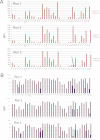No evidence for xenotropic murine leukemia-related virus infection in Sweden using internally controlled multiepitope suspension array serology
- PMID: 22787191
- PMCID: PMC3428384
- DOI: 10.1128/CVI.00391-12
No evidence for xenotropic murine leukemia-related virus infection in Sweden using internally controlled multiepitope suspension array serology
Abstract
Many syndromes have a large number of differential diagnoses, a situation which calls for multiplex diagnostic systems. Myalgic encephalomyelitis (ME), also named chronic fatigue syndrome (CFS), is a common disease of unknown etiology. A mouse retrovirus, xenotropic murine leukemia-related virus (XMRV), was found in ME/CFS patients and blood donors, but this was not corroborated. However, the paucity of serological investigations on XMRV in humans prompted us to develop a serological assay which cover many aspects of XMRV antigenicity. It is a novel suspension array method, using a multiplex IgG assay with nine recombinant proteins from the env and gag genes of XMRV and 38 peptides based on known epitopes of vertebrate gammaretroviruses. IgG antibodies were sought in 520 blood donors and 85 ME/CFS patients and in positive- and negative-control sera from animals. We found no differences in seroreactivity between blood donors and ME/CFS patients for any of the antigens. This did not support an association between ME/CFS and XMRV infection. The multiplex serological system had several advantages: (i) biotinylated protein G allowed us to run both human and animal sera, which is essential because of a lack of XMRV-positive humans; (ii) a novel quality control was a pan-peptide positive-control rabbit serum; and (iii) synthetic XMRV Gag peptides with degenerate positions covering most of the variation of murine leukemia-like viruses did not give higher background than nondegenerate analogs. The principle may be used for creation of variant tolerant peptide serologies. Thus, our system allows rational large-scale serological assays with built-in quality control.
Figures










Similar articles
-
Serologic and PCR testing of persons with chronic fatigue syndrome in the United States shows no association with xenotropic or polytropic murine leukemia virus-related viruses.Retrovirology. 2011 Feb 22;8:12. doi: 10.1186/1742-4690-8-12. Retrovirology. 2011. PMID: 21342521 Free PMC article.
-
No association of xenotropic murine leukemia virus-related virus with prostate cancer or chronic fatigue syndrome in Japan.Retrovirology. 2011 Mar 17;8:20. doi: 10.1186/1742-4690-8-20. Retrovirology. 2011. PMID: 21414229 Free PMC article.
-
Rational recombinant XMRV antigen preparation and bead coupling for multiplex serology in a suspension array.Protein Expr Purif. 2011 Dec;80(2):176-84. doi: 10.1016/j.pep.2011.08.007. Epub 2011 Aug 19. Protein Expr Purif. 2011. PMID: 21871964
-
Xenotropic Murine Leukemia Virus-Related Virus (XMRV) and the Safety of the Blood Supply.Clin Microbiol Rev. 2016 Oct;29(4):749-57. doi: 10.1128/CMR.00086-15. Clin Microbiol Rev. 2016. PMID: 27358491 Free PMC article. Review.
-
False Alarm: XMRV, Cancer, and Chronic Fatigue Syndrome.Annu Rev Virol. 2024 Sep;11(1):261-281. doi: 10.1146/annurev-virology-111821-125122. Epub 2024 Aug 30. Annu Rev Virol. 2024. PMID: 38976866 Review.
Cited by
-
No evidence of xenotropic murine leukemia virus-related virus transmission by blood transfusion from infected rhesus macaques.J Virol. 2013 Feb;87(4):2278-86. doi: 10.1128/JVI.02326-12. Epub 2012 Dec 12. J Virol. 2013. PMID: 23236064 Free PMC article.
-
The saga of XMRV: a virus that infects human cells but is not a human virus.Emerg Microbes Infect. 2014 Apr;3(4):e. doi: 10.1038/emi.2014.25. Epub 2014 Apr 9. Emerg Microbes Infect. 2014. PMID: 26038516 Free PMC article. Review.
-
Compensating for cross-reactions using avidity and computation in a suspension multiplex immunoassay for serotyping of Zika versus other flavivirus infections.Med Microbiol Immunol. 2017 Oct;206(5):383-401. doi: 10.1007/s00430-017-0517-y. Epub 2017 Aug 29. Med Microbiol Immunol. 2017. PMID: 28852878 Free PMC article.
-
Epitopes of microbial and human heat shock protein 60 and their recognition in myalgic encephalomyelitis.PLoS One. 2013 Nov 28;8(11):e81155. doi: 10.1371/journal.pone.0081155. eCollection 2013. PLoS One. 2013. PMID: 24312270 Free PMC article.
-
Serogrouping and seroepidemiology of North European hantaviruses using a novel broadly targeted synthetic nucleoprotein antigen array.Infect Ecol Epidemiol. 2017 Jul 26;7(1):1350086. doi: 10.1080/20008686.2017.1350086. eCollection 2017. Infect Ecol Epidemiol. 2017. PMID: 28815001 Free PMC article.
References
-
- Ablashi DV, et al. 1991. Human herpesvirus 6 (HHV6) and chronic fatigue syndrome (CFS). Can. Dis. Wkly. Rep. 17(Suppl. 1E):33–40 - PubMed
-
- Alberts B. 2011. Retraction. Science 334:1636. - PubMed
-
- Andersson S, et al. 1995. HTLV infections among Swedish intravenous drug users in 1992. Scand. J. Infect. Dis. 27:547–550 - PubMed
-
- Antonsson A, et al. 2010. Prevalence and stability of antibodies to the BK and JC polyomaviruses: a long-term longitudinal study of Australians. J. Gen. Virol. 91:1849–1853 - PubMed
Publication types
MeSH terms
Substances
LinkOut - more resources
Full Text Sources
Research Materials

